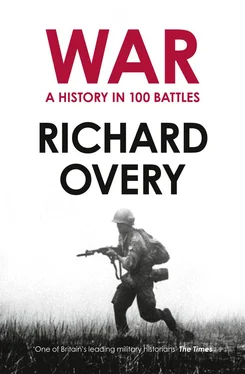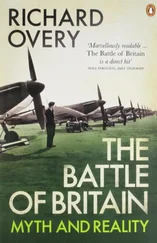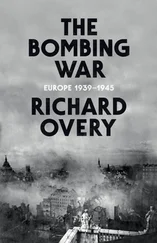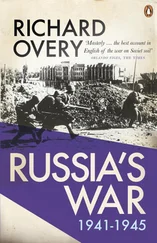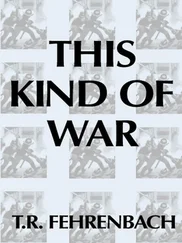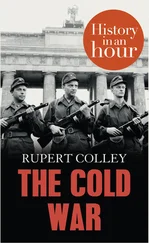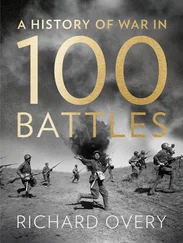The fact that violence between human communities over the past 20,000 years has been sporadic and at times uncommon suggests that warfare must have historical explanations rather than evolutionary ones. The early evidence of violence says little about whether these conflicts were battles as they are understood today, or mere raids for slaves and booty, ambushes to prevent encroachments on food or water sources, or ritualized acts of limited or mock violence like that still evident among tribal communities in early twentieth-century New Guinea. The idea of battle as a way of organizing violence in a disciplined way with a particular aim and a specific enemy is, according to the historical record, common only to particular cultures and across particular global regions. A study of the 2,000 years from the second millennium BCE to around 500 CE – the period when battles entered the historical record – has shown that battles were rare in most civilizations and that they were concentrated geographically in a swathe of territory from Mediterranean Europe through the Near East to Southern Asia. Out of 288 conflicts worthy of the name ‘battle’, 94 per cent occurred in this region, including 73 battles in civil wars. China records only two major battles over the same time span. The idea of a battle as a distinct event with its own choreography and rules seems to have been an invention of pharaonic Egypt. It was widely imitated in the Near and Middle East, and taken up with enthusiasm by the ancient Greeks and the Romans.
This is the form of battle that is familiar today and clearly it came to be widely imitated in the millennia that followed. That is not to say that all battles are equal. The exact ways in which battles have been organized and conducted over the past 2,000 years closely reflect specific cultures and prevailing historical conditions, for which anthropology is as useful as history. There have been periods when efforts were made to avoid battle, even when large armies were available. Late medieval Europe saw infrequent battles if deterrence, threats or political cunning could avoid them; eighteenth-century Europe saw a preference for manoeuvre warfare, in which armies were moved around as if on some giant chessboard with the aim to checkmate an opponent rather than force a real fight. Early modern warfare in Southeast Asia was limited by the desire to avoid battle while finding ways of seizing slaves or workers, though this did not exclude occasional conflicts of extreme violence. The refusal to accept battle, even when two armies are only miles apart, as Octavian did at Actium to frustrate Mark Antony, is highly ritualized and relies on what is regarded as culturally acceptable to both sides. Different cultures have evidently defined battle differently, from the sacred ritual surrounding Greek warfare to the utilitarian view of battle in modern warfare.
The one common denominator for all the battles identified from the historical record is the dependence on state or sub-state forms of organization that are capable of raising an army, seeing to its provisioning, and imposing sufficient levels of discipline (with the incentive of loot or the threat of punishment) to ensure that the rank and file remain in place long enough to fight. The capacity to raise an army does not mean a settled and powerful civilization. American Indian tribes could collaborate sufficiently to bring an army of warriors together long enough to achieve what was needed; the Mongol tribal units integrated by Genghis Khan into a completely militarized society represented a loose federation, but it was organized enough to divide men into divisions, battalions and platoons and to provide camels, oxen and carts to move the arrows and the few provisions that the steppe soldiers needed. The other requirement was money, and warfare played a central part in the creation of complex coinage and taxation systems – the cost of warfare was likely to exceed what could be supplied by the potential field force or navy on its own behalf. As battles became more complex with the addition of elaborate equipment and the need for large supplies of ammunition, food or weapons, Western societies came to dominate global warfare, though not exclusively so. They developed states and industrial economies capable of raising the technological and organizational threshold of conflict and applying more managerial values to the battlefield. The result since the eighteenth century was the onset of widespread asymmetric warfare between the West and the rest, though the odds could sometimes be overcome if traditional communities gained access to the new weaponry or if they could surprise their opponent. Increasingly, the only way to conduct modern battle was to borrow the Western way of war, as the Japanese navy demonstrated to devastating effect at Pearl Harbor. Even in this case, old and new mingled together as the bushido values of the Japanese military made surrender impossible, leaving some soldiers fighting to the death in the Pacific War armed only with swords.
If the cultural differences between battles in different eras and regions make it impossible to generalize about the historical circumstances that explain battle, some explanation is needed for the explosion in the number of battles fought over the last 1,500 years. The eighteenth-century English clergyman Thomas Malthus famously described the problems caused by overpopulation, which result in wars, disease and famine, all of which bring population back to levels the local environment can support. Population growth in the prehistoric age necessitated a search for additional resources, such as pasture, game or raw materials. If this coincides with adverse climate change, as seems to have been the case among the prehistoric native populations of the southwestern United States, then communities are compelled to violent competition for new resources. It would be wrong, however, to see this solely as a prehistoric solution. Changes in population levels in the vast Eurasian steppes partly explain the surges of violent migration and raiding from central Asia for hundreds of years in the first millennium CE. One of the excuses given centuries later for Hitler’s wars of aggression was the German search for Lebensraum (‘Living Space’) so that territory and resources could match population size. When Japan found access to additional resources for her overcrowded islands blocked off by the international economic crisis, the solution was invasion of China and, eventually, the seizure of resources and territory in Southeast Asia.
This suggests crude biological or material imperatives that are all too often overlooked or denied when describing human history, but which clearly act at certain historical moments as a driver towards conflict. There is, of course, an important difference between human and animal populations when faced with food shortages, climate change and competition for resources. Human beings are conscious of what they do. War is clearly the product of growing social and political organization, and the evolution of ideologies or cultures that see conflict as justified by defining the enemy ‘other’, whether it is the Persian Empire, the barbarians of the great migrations or the infidels and pagans defined by the mass religions. In the period from the early medieval world, when battles occur almost ceaselessly, religion runs as a clear thread through hundreds of them. When the Sudanese Mahdist forces attacked the British expeditionary force at Omdurman in 1898, they cried out ‘Fight the infidel for the cause of God!’ as they rushed towards the British machine guns. Not all religions have preached virtuous battle, but those that have – in particular Christianity and Islam in all their different guises – see some form of holy war, whether jihad or crusade, as a divine injunction. The political religions of the last century, fascism and communism, preached simply a secular version of holy war, justified by national struggle or the class war. Ideologies, religious or otherwise, were (and still are) capable of exerting an exceptional psychological pressure to accept self-sacrifice for the sake of a cause defined as noble or sacred.
Читать дальше
